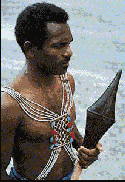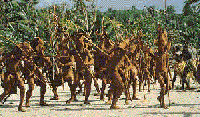Solomon Islands Literature




"In the Solomon Islands as throughout Melanesia beliefs about origins, not only of men but also of animals, plants, and social customs are frequently linked with certain archetypal themes, one of which is the myth of the ogre-killing child born to an abandoned woman. Other related themes concern abandoned women who mate with animals or birds or abandoned children who are suckled by animals or birds. Very often one of two hostile brothers or one of a band of brothers is regarded as a creator. Then there are the myths about a snake relative who is killed and from whose body comes various forms."
"One of these stories come from the district of Medina and is about Marruni the earthquake, who had a human body that ended in snake's tail which he kept hidden from his wives. One day they returned from the garden early without giving the warning signal and discovered him sunning himself. He sent them away and cut his tail into segments. He gave a clan name to some pieces and from each of these came the people of that clan. From others came birds, snakes, fish and pigs. Marruni is said to have come from the tiny offshore island of Tabar, which seemed to have been the home of the germinal culture of the area, and to have brought the malanggin or memorial rights for the dead with him from there."
"Hatuibwari of the Arosi district was a winged serpent with a human head, four eyes and four breasts and he suckled all he created. The greatest of all these figona was Agunua who was thought to embrace all the others who were merely his representatives or incarnations. He made all kinds of vegetables and fruits but his brother burnt some of these in the oven, making them forever inedible. He made a male child who was helpless at caring for himself so he created a woman to make fire, cook and weed the gardens. The first drinking coconut from the tree was sacred to him."
"In a story from New Ireland, there was a great devouring pig who caused the villagers to flee to the offshore island of Tabar, leaving Tsenabonpil behind because she had a swollen leg, so heavy it would have sunk the canoe. She mated with a bird and produced twin boys who killed the pig. The woman sent the pig's hair attached to a coconut leaf to Tabar as a sign. The fugitives returned and Tsenabonpil allocated them to different clans and assigned them their totems so that they would know how to behave towards one another. She also taught them magic and other skills."
Extract from Cranstone and Starzecka The Solomon Islanders [p15 -16]
Warfare was endemic. It varied from a traditional and continuing state of war between communities to sudden, temporary outbreaks of raiding or ambush. The number of individuals involved could be a few or a few hundred but casualties in any one confrontation were usually slight. Traditionally in all the larger islands and some of the smaller ones there was antagonism between the inhabitants of the interior, the 'bush people', and the coast dwellers , the 'saltwater people'. This hostility was linked with cultural differences between the two groups: the bush people relied on agriculture whereas for many coastal people fishing was the mainstay of the economy and the sea-going canoes gave them mobility which the bush people were denied. In conflicts, the coast dwellers were usually aggressors and victors.
Headhunting was restricted to the central Solomons and had religious importance, heads being associated with mana and the ancestor cult. The custom of preserving heads as trophies existed throughout the islands. This was done as a sign of power and success, whether the heads were those of enemies or transgressors within the community. Headhunting was also carried out on an individual basis by professional headhunters whose services could be obtained upon promise of payment of 'blood money'. Cannibalism was practised locally but usually not concurrently with headhunting. It had ceremonial character, the victim being a sacrifice.
The principal weapons were spears, clubs and bows and arrows. The spear was the main fighting weapon, used both for thrusting and throwing. Spears were usually made of palmwood and had multiple barbs either carved or made of wood or bone and lashed to the head. Foreshafts were decorated with plaiting of yellow, red and black orchid stems in the north-west and were carved or had pearl-shell inlay in the south-east. ...
Clubs were made of wood and were used to deflect spears and to administer the coup de gr’ce as well as for hand-to-hand fighting. The clubs of Malaita and Ulawa were lozenge or baton-shaped and had coconut-fibre binding at the butt end. In the central islands clubs were often paddle-shaped. Shafts were decorated with plaiting of coloured vegetable fibre or the butt end had a carving of small human figures. One type of San Cristobal club had a very distinctive sickle shape and was especially well adapted to parrying spears. They could be decorated with carving or pearl-shell inlay. Stone-headed clubs used as weapons occurred in Rennell and Bellona. In Malaita the small stone-headed clubs with shafts inlaid with pearl shell were for ceremonial use. Other ceremonial clubs differed from functional weapons by the richness of decoration, the basic shape being the same.
Bows were used locally but widely. Arrows had reed shafts and palmwood foreshafts and were not feathered. They had barbs, either carved or lashed on; especially dangerous were arrows with barbs of human bone for they contained mana of the dead man. In Bougainville barbs were deeply undercut so that the head broke off in the wound. ... Arrows were never poisoned but magical substances (which could cause tetanus) might be smeared on them.
The sling was used in some localities, mainly for attacking tree houses. Shields were used in many areas. They were usually narrow and light, made of wicker or parallel slats lashed together. In Florida and Guadalcanal oval wicker shields were used; in Ysabel and Choiseul, rectangular slab shields. Elaborately decorated shields, with designs of pearl-shell inlay and shell beads, were purely ceremonial, used in presentations among chiefs.